Geospatial Simulation Model of Deforestation and Reforestation Using Multicriteria Evaluation
Abstract
:1. Introduction
2. Materials and Methods
2.1. Study Area
2.2. Data
2.3. Methodology
2.4. Selection and Preprocessing of Data
2.5. Demand for Land Use
2.6. Geospatial Simulation Using MCE
2.7. Indicators and Mapping of Carbon Loss and Capture
3. Results
3.1. Land Use Demand
3.2. Geospatial Simulation Using MCE
3.3. Indicators and Mapping of Carbon Loss and Capture
4. Discussion
5. Conclusions
Author Contributions
Funding
Acknowledgments
Conflicts of Interest
References
- Swedan, N. Deforestation and land farming as regulators of population size and climate. Acta Ecol. Sin. 2020, 40, 443–450. [Google Scholar] [CrossRef]
- Buizer, M.; Humphreys, D.; De Jong, W. Climate change and deforestation: The evolution of an intersecting policy domain. Environ. Sci. Policy 2014, 35, 1–11. [Google Scholar] [CrossRef] [Green Version]
- Sekhran, N.; Bovarnick, A.; Scott, T.; Corcoran, J. Biodiversity, Development and Poverty Alleviation. 2010. Available online: https://www.cbd.int/doc/bioday/2010/idb-2010-booklet-en.pdf (accessed on 10 December 2020).
- FAO. Global Forest Resources Assessment 2020 Key Findings. Available online: http://www.fao.org/3/CA8753EN/CA8753EN.pdf (accessed on 23 June 2020).
- Panday, P.K.; Coe, M.T.; Macedo, M.N.; Lefebvre, P.; Castanho, A.D.A. Deforestation offsets water balance changes due to climate variability in the Xingu River in eastern Amazonia. J. Hydrol. 2015, 523, 822–829. [Google Scholar] [CrossRef]
- Houghton, R. Carbon emissions and the drivers of deforestation and forest degradation in the tropics. Curr. Opin. Environ. Sustain. 2012, 4, 597–603. [Google Scholar] [CrossRef]
- Gao, J.; Gao, H.; Zhou, C.; Zhang, X. The impact of land-use change on water-related ecosystem services: A study of the Guishui River Basin, Beijing, China. J. Clean. Prod. 2017, 163, S148–S155. [Google Scholar] [CrossRef]
- Mohebalian, P.M.; Aguilar, F.X. Design of tropical forest conservation contracts considering risk of deforestation. Land Use Policy 2018, 70, 451–462. [Google Scholar] [CrossRef]
- Gingrich, S.; Lauk, C.; Niedertscheider, M.; Pichler, M.; Schaffartzik, A.; Schmid, M.; Mager, A.; Noë, J.; Bhan, M.; Erb, K. Hidden emissions of forest transitions: A socio-ecological reading of forest change. Curr. Opin. Environ. Sustain. 2019, 38, 14–21. [Google Scholar] [CrossRef]
- Moomaw, W.R.; Law, B.E.; Goetz, S.J. Focus on the role of forests and soils in meeting climate change mitigation goals: Summary. Environ. Res. Lett. 2020, 15, 1–9. [Google Scholar] [CrossRef]
- Dooley, K.; Kartha, S. Land-based negative emissions: Risks for climate mitigation and impacts on sustainable development. Int. Environ. Agreem. 2018, 18, 79–98. [Google Scholar] [CrossRef]
- Singh, S.; Reddy, C.S.; Pasha, S.V.; Dutta, K.; Saranya, K.R.L.; Satish, K.V. Modeling the spatial dynamics of deforestation and fragmentation using Multi-Layer Perceptron neural network and landscape fragmentation tool. Ecol. Eng. 2017, 99, 543–551. [Google Scholar] [CrossRef]
- Overmars, K.P.; Verburg, P.H. Multilevel modelling of land use from field to village level in the Philippines. Agric. Syst. 2006, 89, 435–456. [Google Scholar] [CrossRef]
- Verburg, P.H.; Overmars, K.P.; Huigen, M.G.A.; de Groot, W.T.; Veldkamp, A. Analysis of the effects of land use change on protected areas in the Philippines. Appl. Geogr. 2006, 26, 153–173. [Google Scholar] [CrossRef]
- Bax, V.; Francesconi, W.; Quintero, M. Spatial modeling of deforestation processes in the Central Peruvian Amazon. J. Nat. Conserv. 2016, 29, 79–88. [Google Scholar] [CrossRef]
- De Barros Ferraz, S.F.; Vettorazzi, C.A.; Theobald, D.M.; Ballester, M.V.R. Landscape dynamics of Amazonian deforestation between 1984 and 2002 in central Rondônia, Brazil: Assessment and future scenarios. For. Ecol. Manag. 2005, 204, 69–85. [Google Scholar] [CrossRef]
- Hurtado Pidal, J.R. Analysis, Modeling and Spatial Simulation of the Land Cover Change, between Natural Areas and Those of Anthropic Origin in the Province of Napo (Ecuador), for the Period 1990–2020. Master’s Thesis, Universidad Nacional de La Plata, Buenos Aires, Argentina, 2014. [Google Scholar]
- Rodríguez-Eraso, N. Land-Cover and Land-Use Change and Deforestation in Colombia: Spatial Dynamics, Drivers and Modelling. Ph.D. Thesis, Universitat Autònoma de Barcelona, Barcelona, Spain, 2011. [Google Scholar]
- Gibon, A.; Sheeren, D.; Monteil, C.; Ladet, S.; Balent, G. Modelling and simulating change in reforesting mountain landscapes using a social-ecological framework. Landsc. Ecol. 2010, 25, 267–285. [Google Scholar] [CrossRef] [Green Version]
- An, L.; Linderman, M.; Qi, J.; Shortridge, A.; Liu, J. Exploring complexity in a human-environment system: An agent-based spatial model for multidisciplinary and multiscale integration. Ann. Assoc. Am. Geogr. 2005, 95, 54–79. [Google Scholar] [CrossRef]
- Matthews, R.B.; Gilbert, N.G.; Roach, A.; Polhill, J.G.; Gotts, N.M. Agent-based land-use models: A review of applications. Landsc. Ecol. 2007, 22, 1447–1459. [Google Scholar] [CrossRef] [Green Version]
- Moreno, N.; Quintero, R.; Ablan, M.; Barros, R.; Dávila, J.; Ramírez, H.; Tonella, G.; Acevedo, M.F. Biocomplexity of deforestation in the Caparo tropical forest reserve in Venezuela: An integrated multi-agent and cellular automata model. Environ. Model. Softw. 2007, 22, 664–673. [Google Scholar] [CrossRef]
- Babbar, D.; Areendran, G.; Sahana, M.; Sarma, K.; Raj, K.; Sivadas, A. Assessment and prediction of carbon sequestration using Markov chain and InVEST model in Sariska Tiger Reserve, India. J. Clean. Prod. 2021, 278, 123333. [Google Scholar] [CrossRef]
- Franco Prieto, C.A. Development of a Model Based on Multicriteria Spatial Analysis for the Determination of Forest Management Units. Case of the Department of Casanare. Master’s Thesis, Universidad Nacional de Colombia, Bogota, Colombia, 2011. [Google Scholar]
- Maestripieri, N.; Houet, T.; Paegelow, M.; Selleron, G.; Toro Balbontín, D.; Sáez Villalobos, N. Dynamic simulation of forest management normative scenarios: The case of timber plantations in the southern Chile. Futures 2017, 87, 65–77. [Google Scholar] [CrossRef]
- Silva, A.C.O.; Fonseca, L.M.G.; Körting, T.S.; Escada, M.I.S. A spatio-temporal Bayesian Network approach for deforestation prediction in an Amazon rainforest expansion frontier. Spat. Stat. 2020, 35, 100393. [Google Scholar] [CrossRef]
- Jiang, Q.; Cheng, Y.; Jin, Q.; Deng, X.; Qi, Y. Simulation of Forestland Dynamics in a Typical Deforestation and Afforestation Area under Climate Scenarios. Energies 2015, 8, 10558–10583. [Google Scholar] [CrossRef]
- Zupko, R.; Rouleau, M. ForestSim: Spatially explicit agent-based modeling of non-industrial forest owner policies. SoftwareX 2019, 9, 117–125. [Google Scholar] [CrossRef]
- Zambelli, P.; Lora, C.; Spinelli, R.; Tattoni, C.; Vitti, A.; Zatelli, P.; Ciolli, M. A GIS decision support system for regional forest management to assess biomass availability for renewable energy production. Environ. Model. Softw. 2012, 38, 203–213. [Google Scholar] [CrossRef]
- Thapa, R.B.; Shimada, M.; Watanabe, M.; Motohka, T.; Shiraishi, T. L-band SAR data and spatially explicit model to analyse forest loss between 2007 and 2030 in central Sumatra. In Proceedings of the 2013 Asia-Pacific Conference on Synthetic Aperture Radar (APSAR), Tsukuba, Japen, 23–27 September 2013; pp. 108–111. [Google Scholar]
- Mas, F.-J.; Sorani, V.; Alvarez, R. Elaboración de un Modelo de Simulación del Proceso de Deforestación. Investig. Geogr. 1996, 43–57. Available online: https://www.redalyc.org/pdf/569/56909907.pdf (accessed on 21 January 2019).
- Jaimes, N.B.P.; Sendra, J.B.; Delgado, M.G.; Plata, R.F.; Némiga, X.A.; Solís, L.R.M. Determination of Optimal Zones for Forest Plantations in the State of Mexico Using Multi-Criteria Spatial Analysis and GIS. J. Geogr. Inf. Syst. 2012, 4, 204–218. [Google Scholar] [CrossRef] [Green Version]
- Sahagún-Sánchez, F.J.; Reyes-Hernández, H.; Flores, J.L.F.; Vargas, L.C. Modeling of scenarios of potential change in vegetation and land use in the Sierra Madre Oriental de San Luis Potosí, Mexico. J. Lat. Am. Geogr. 2011, 10, 65–86. [Google Scholar] [CrossRef]
- Mas, J.-F.; Flamenco, A. Modeling of Land Cover/Use Changes in a Tropical Region of Mexico. Available online: http://www.geotropico.org/NS_5_1_Mas-Flamenco.pdf (accessed on 21 January 2019).
- Leija-Loredo, E.; Reyes-Hernandez, H.; Reyes-Perez, O.; Flores-Flores, J.; Sahagún-Sanchéz, F. Changes in vegetation cover, land uses and future scenarios in the coastal region of the state of Oaxaca, Mexico. Madera y Bosques 2016, 22, 125–140. [Google Scholar]
- Piontekowski, V.J.; Ribeiro, F.P.; Matricardi, E.A.T.; Lustosa, I.M.; Bussinguer, A.P.; Gatto, A. Modeling deforestation in the state of Rondonia. Floresta e Ambiente 2019, 26, 20180441. [Google Scholar] [CrossRef] [Green Version]
- Ayele, G.; Hayicho, H.; Alemu, M. Land Use Land Cover Change Detection and Deforestation Modeling: In Delomena District of Bale Zone, Ethiopia. J. Environ. Prot. 2019, 10, 532–561. [Google Scholar] [CrossRef] [Green Version]
- Naffaa, S.; van Beek, L.P.H.; Dunn, F.E.; de Jong, S. Modeling the changing sediment yield of the Amazon under climate change and deforestation scenarios and the possible impacts on the Guiana coast. In Proceedings of the 22nd EGU General Assembly (EGUGA 2020), Online, 4–8 May 2020; p. 18621. [Google Scholar]
- Lochhead, K.; Ghafghazi, S.; LeMay, V.; Bull, G.Q. Examining the vulnerability of localized reforestation strategies to climate change at a macroscale. J. Environ. Manag. 2019, 252, 109625. [Google Scholar] [CrossRef] [PubMed]
- Lieffers, V.J.; Pinno, B.D.; Beverly, J.L.; Thomas, B.R.; Nock, C. Reforestation policy has constrained options for managing risks on public forests. Can. J. For. Res. 2020, 50, 855–861. [Google Scholar] [CrossRef]
- Manson, S.M. Agent-based modeling and genetic programming for modeling land change in the Southern Yucatán Peninsular Region of Mexico. Agric. Ecosyst. Environ. 2005, 111, 47–62. [Google Scholar] [CrossRef]
- House, J.I.; Colin Prentice, I.; Le Quéré, C. Maximum impacts of future reforestation or deforestation on atmospheric CO2. Glob. Chang. Biol. 2002, 8, 1047–1052. [Google Scholar] [CrossRef]
- Nakicenovic, N.; Alcamo, J.; Davis, G.; de Vries, B. Emissions Scenarios; Cambridge University Press: Cambridge, UK, 2000. [Google Scholar]
- Veldkamp, E.; Schmidt, M.; Powers, J.S.; Al, E. Deforestation and reforestation impacts on soils in the tropics. Nat. Rev. Earth Environ. 2020, 1, 590–605. [Google Scholar] [CrossRef]
- INEGI. Uso de Suelo y Vegetación. Available online: http://www.beta.inegi.org.mx/temas/mapas/usosuelo/ (accessed on 27 August 2019).
- INEGI. Encuesta Intercensal 2015. Available online: http://www.beta.inegi.org.mx/proyectos/enchogares/especiales/intercensal/ (accessed on 27 August 2019).
- CONAGUA, C.N. del A. Programa Hídrico Regional Visión 2030. Región Hidrológico-Administrativa III Pacífico Norte. Available online: http://www.conagua.gob.mx/conagua07/publicaciones/publicaciones/3-sgp-17-12pn.pdf (accessed on 27 August 2019).
- CONAGUA, C.N. del A. Estadísticas Agrícolas de los Distritos de Riego Año agrícola 2013–2014. Available online: https://bpo.sep.gob.mx/#/recurso/615 (accessed on 27 August 2019).
- Monjardín-Armenta, S.A.; Pacheco-Angulo, C.E.; Plata-Rocha, W.; Corrales-Barraza, G. Deforestation and its causal factors in the state of Sinaloa, Mexico. Madera Bosques 2017, 23, 7. [Google Scholar] [CrossRef] [Green Version]
- Osorio, L.P.; Mas, J.-F.; Guerra, F.; Maass, M. Analysis and modeling of deforestation processes: A case study in the Coyuquilla River Basin, Guerrero, Mexico. Investig. Geogr. 2015, 88, 60–74. [Google Scholar] [CrossRef] [Green Version]
- Pineda Jaimes, N.B.; Bosque Sendra, J.; Gómez Delgado, M.; Franco Plata, R. Exploring the driving forces behind deforestation in the state of Mexico (Mexico) using geographically weighted regression. Appl. Geogr. 2010, 30, 576–591. [Google Scholar] [CrossRef]
- INECC; CONAFOR. First Biennial Update Report to the United Nations Framework Convention on Climate Change Executive Summary. Available online: https://unfccc.int/sites/default/files/resource/ExecutiveSummary_1.pdf (accessed on 21 November 2019).
- SEGOB. Programa Nacional Forestal 2014–2018. Available online: http://dof.gob.mx/nota_detalle.php?codigo=5342498&fecha=28/04/2014 (accessed on 14 February 2019).
- CONAFOR. Estrategia Nacional para REDD+. Available online: http://www.conafor.gob.mx:8080/documentos/docs/35/5559ElementosparaeldiseñodelaEstrategiaNacionalparaREDD_.pdf (accessed on 26 February 2019).
- FAO. The State of the World’s Forests Forests and Agriculture: Challenges and Opportunities. Available online: http://www.fao.org/3/a-i5850s.pdf (accessed on 26 February 2019).
- Li, H.; Ma, Z.; Zhu, Y.; Liu, Y.; Yang, X. Planning and prioritizing forest landscape restoration within megacities using the ordered weighted averaging operator. Ecol. Indic. 2020, 116, 106499. [Google Scholar] [CrossRef]
- Irina, L.T.; Javier, B.P.; Teresa, C.B.M.; Eurídice, L.A.; Luz María del Carmen, C.I. Integrating ecological and socioeconomic criteria in a GIS-based multicriteria-multiobjective analysis to develop sustainable harvesting strategies for Mexican oregano Lippia graveolens Kunth, a non-timber forest product. Land Use Policy 2019, 81, 668–679. [Google Scholar] [CrossRef]
- Saaty, T. The Analytic Hierarchy Process: Planning, Priority Setting, Resource Allocation; McGraw-Hill International Book Co.: New York, NY, USA; London, UK, 1980; ISBN 0070543712. [Google Scholar]
- Aydi, A. Evaluation of groundwater vulnerability to pollution using a GIS-based multi-criteria decision analysis. Groundw. Sustain. Dev. 2018, 7, 204–211. [Google Scholar] [CrossRef]
- Azareh, A.; Rafiei Sardooi, E.; Choubin, B.; Barkhori, S.; Shahdadi, A.; Adamowski, J.; Shamshirband, S. Incorporating multi-criteria decision-making and fuzzy-value functions for flood susceptibility assessment. Geocarto Int. 2019, 1–21. [Google Scholar] [CrossRef]
- Saltelli, A.; Tarantola, S.; Chan, K.P.S. A quantitative model-independent method for global sensitivity analysis of model output. Technometrics 1999, 41, 39–56. [Google Scholar] [CrossRef]
- Brunetti, G.; Šimůnek, J.; Turco, M.; Piro, P. On the use of global sensitivity analysis for the numerical analysis of permeable pavements. Urban Water J. 2018, 15, 269–275. [Google Scholar] [CrossRef] [Green Version]
- Lahiji, R.N.; Dinan, N.M.; Liaghati, H.; Ghaffarzadeh, H.; Vafaeinejad, A. Scenario-based estimation of catchment carbon storage: Linking multi-objective land allocation with InVEST model in a mixed agriculture-forest landscape. Front. Earth Sci. 2020. [Google Scholar] [CrossRef]
- Verburg, P.H.; Alexander, P.; Evans, T.; Magliocca, N.R.; Malek, Z.; Rounsevell, M.D.A.; van Vliet, J. Beyond land cover change: Towards a new generation of land use models. Curr. Opin. Environ. Sustain. 2019, 38, 77–85. [Google Scholar] [CrossRef]
- Roodposhti, M.S.; Aryal, J.; Bryan, B.A. A novel algorithm for calculating transition potential in cellular automata models of land-use/cover change. Environ. Model. Softw. 2019, 112, 70–81. [Google Scholar] [CrossRef]
- Stan, K.; Sanchez-Azofeifa, A. Deforestation and secondary growth in Costa Rica along the path of development. Reg. Environ. Chang. 2019, 19, 587–597. [Google Scholar] [CrossRef]
- Gracelli, R.R.; Magalhaes, I.B.; Santos, V.J.; Calijuri, M.L. Effects on Streamflow Caused by Reforestation and Deforestation in A Brazilian Southeast Basin: Evaluation by Multicriteria Analysis and Swat Model. In Proceedings of the 2020 IEEE Latin American GRSS and ISPRS Remote Sensing Conference (LAGIRS 2020), Santiago, Chile, 22–26 March 2020; pp. 167–172. [Google Scholar]
- Follador, M.; Villa, N.; Paegelow, M.; Renno, F.; Bruno, R. Tropical deforestation modelling: Comparative analysis of different predictive approaches. The case study of Peten, Guatemala. Environ. Sci. Eng. 2008, 77–107. [Google Scholar] [CrossRef] [Green Version]
- González-Elizon, M.S.; González-Elizondo, M.; Tena-Flores, J.A.; Ruacho-González, L.; López-Enríquez, I.L. Vegetation of the Sierra Madre Occidental, Mexico: A synthesis. Acta Bot. Mex. 2012, 100, 351–403. [Google Scholar] [CrossRef] [Green Version]
- Dyderski, M.K.; Jagodziński, A.M. Drivers of invasive tree and shrub natural regeneration in temperate forests. Biol. Invasions 2018, 20, 2363–2379. [Google Scholar] [CrossRef] [Green Version]
- Stanturf, J.A.; Palik, B.J.; Dumroese, R.K. Contemporary forest restoration: A review emphasizing function. For. Ecol. Manag. 2014, 331, 292–323. [Google Scholar] [CrossRef]
- Dey, D.C.; Knapp, B.O.; Battaglia, M.A.; Deal, R.L.; Hart, J.L.; O’Hara, K.L.; Schweitzer, C.J.; Schuler, T.M. Barriers to natural regeneration in temperate forests across the USA. New For. 2019, 50, 11–40. [Google Scholar] [CrossRef]
- Gerlein-Safdi, C.; Keppel-Aleks, G.; Wang, F.; Frolking, S.; Mauzerall, D.L. Satellite Monitoring of Natural Reforestation Efforts in China’s Drylands. One Earth 2020, 2, 98–108. [Google Scholar] [CrossRef] [Green Version]
- Almeida, D.R.A.; Stark, S.C.; Chazdon, R.; Nelson, B.W.; Cesar, R.G.; Meli, P.; Gorgens, E.B.; Duarte, M.M.; Valbuena, R.; Moreno, V.S.; et al. The effectiveness of lidar remote sensing for monitoring forest cover attributes and landscape restoration. For. Ecol. Manag. 2019, 438, 34–43. [Google Scholar] [CrossRef]
- Ma, L.; Bicking, S.; Müller, F. Mapping and comparing ecosystem service indicators of global climate regulation in Schleswig-Holstein, Northern Germany. Sci. Total Environ. 2019, 648, 1582–1597. [Google Scholar] [CrossRef]
- Maes, J.; Fabrega, N.; Zulian, G.; Barbosa, A.; Ivits, E.; Polce, C.; Vandecasteele, I.; Marí, I.; Guerra, C.; Castillo, C.P.; et al. Mapping and Assessment of Ecosystems and Their Services Trends in Ecosystems and Ecosystem—JRC Report Number JRC94889. Available online: http://publications.jrc.ec.europa.eu/repository/handle/JRC94889 (accessed on 14 October 2020).
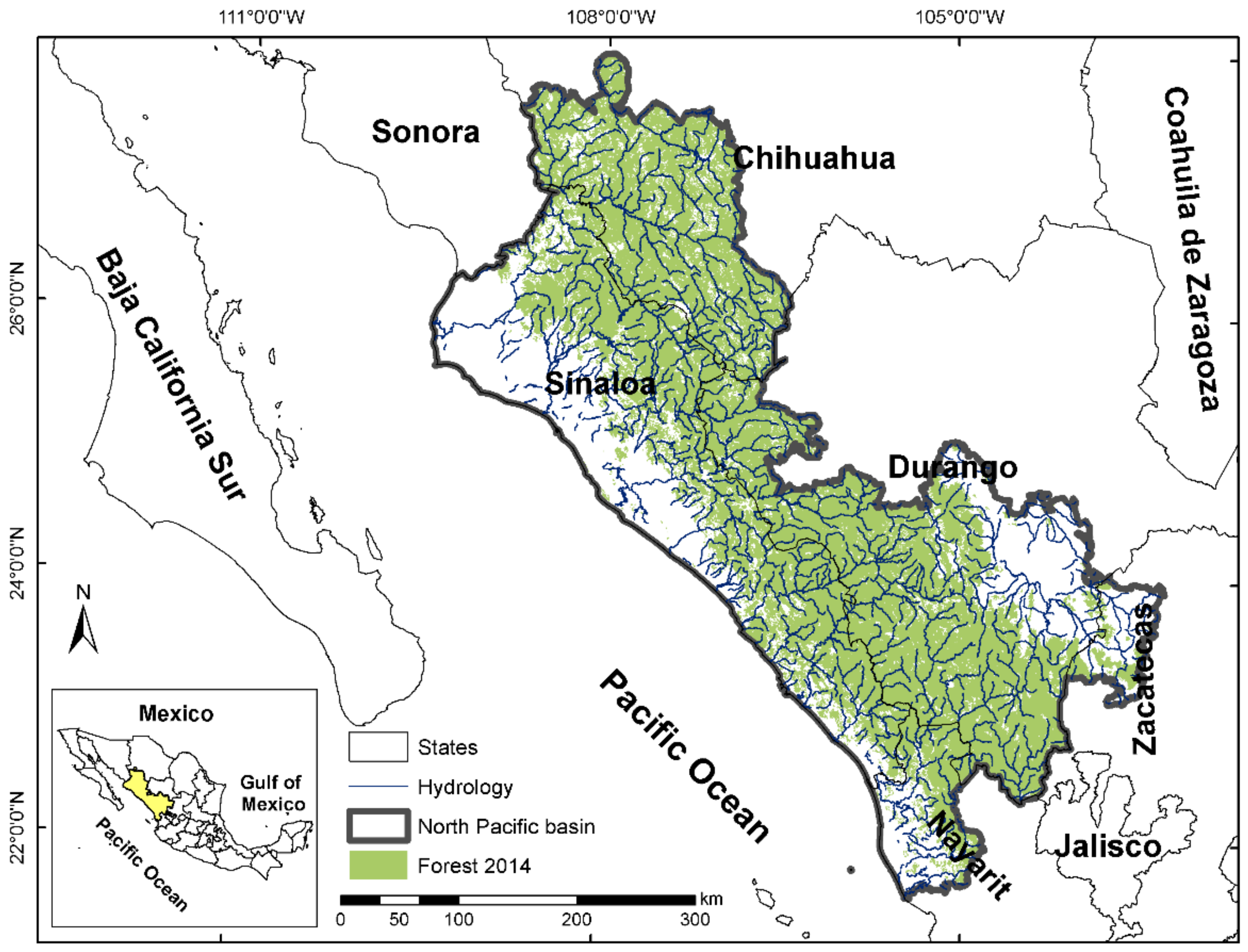

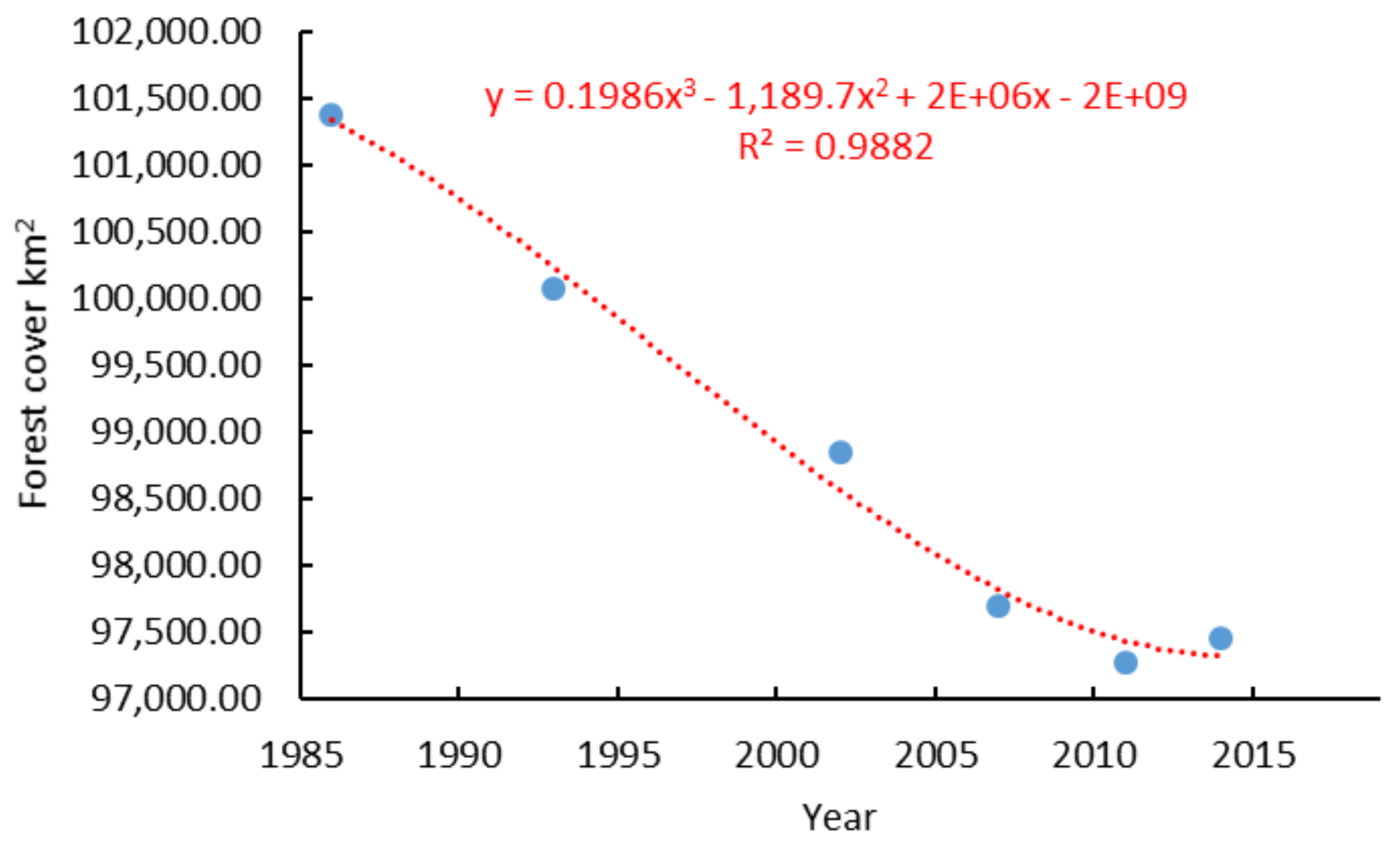
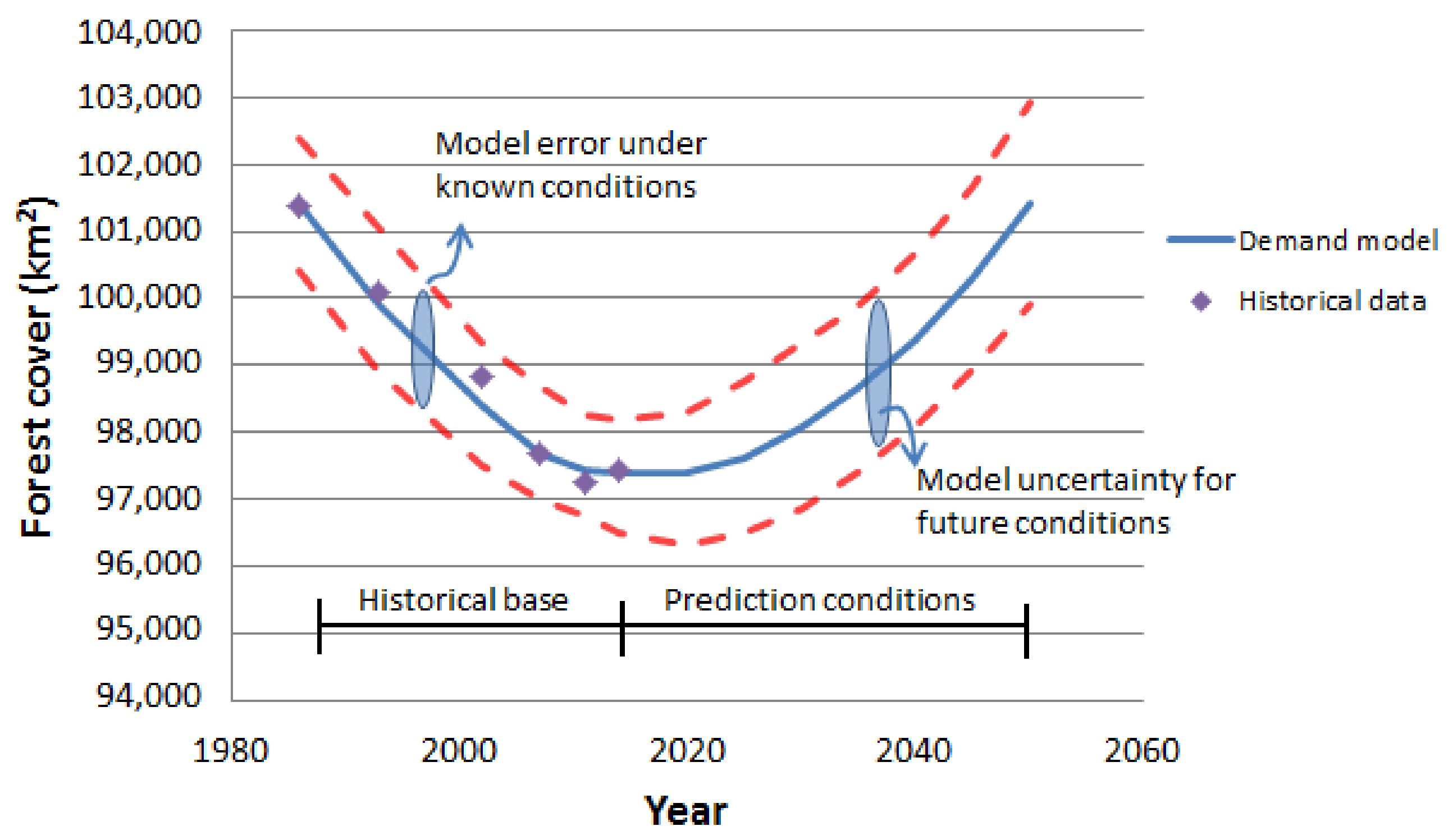

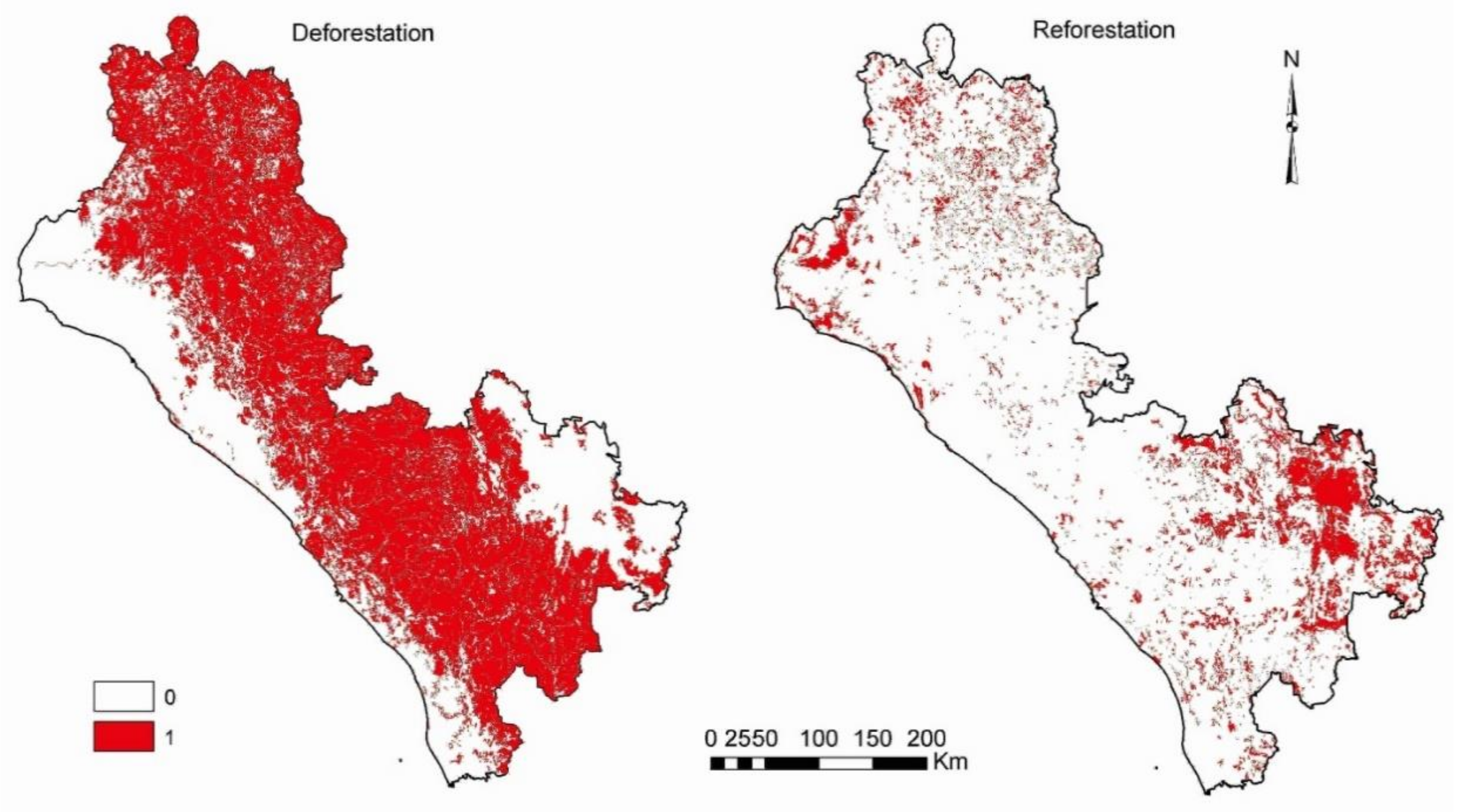
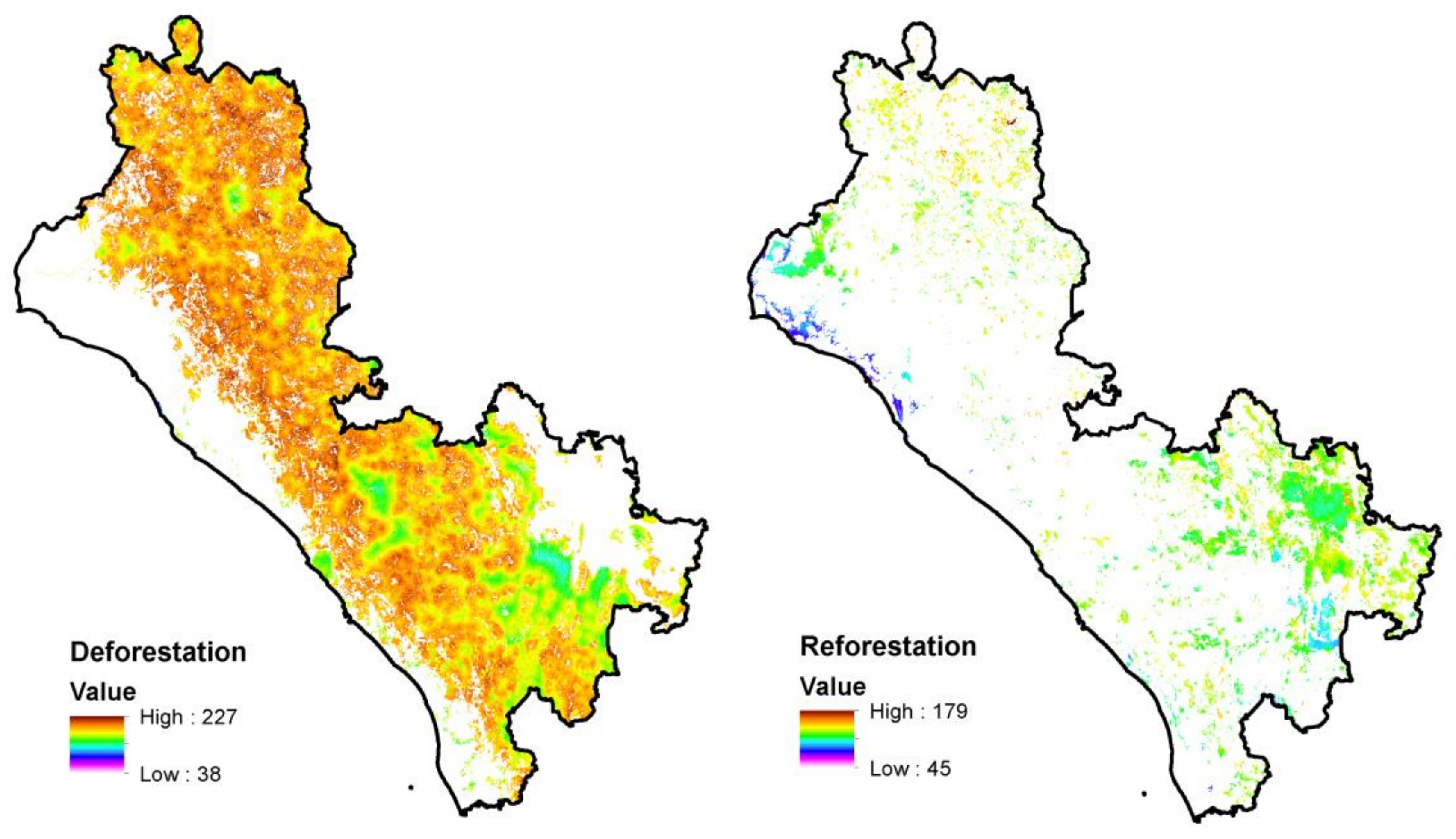
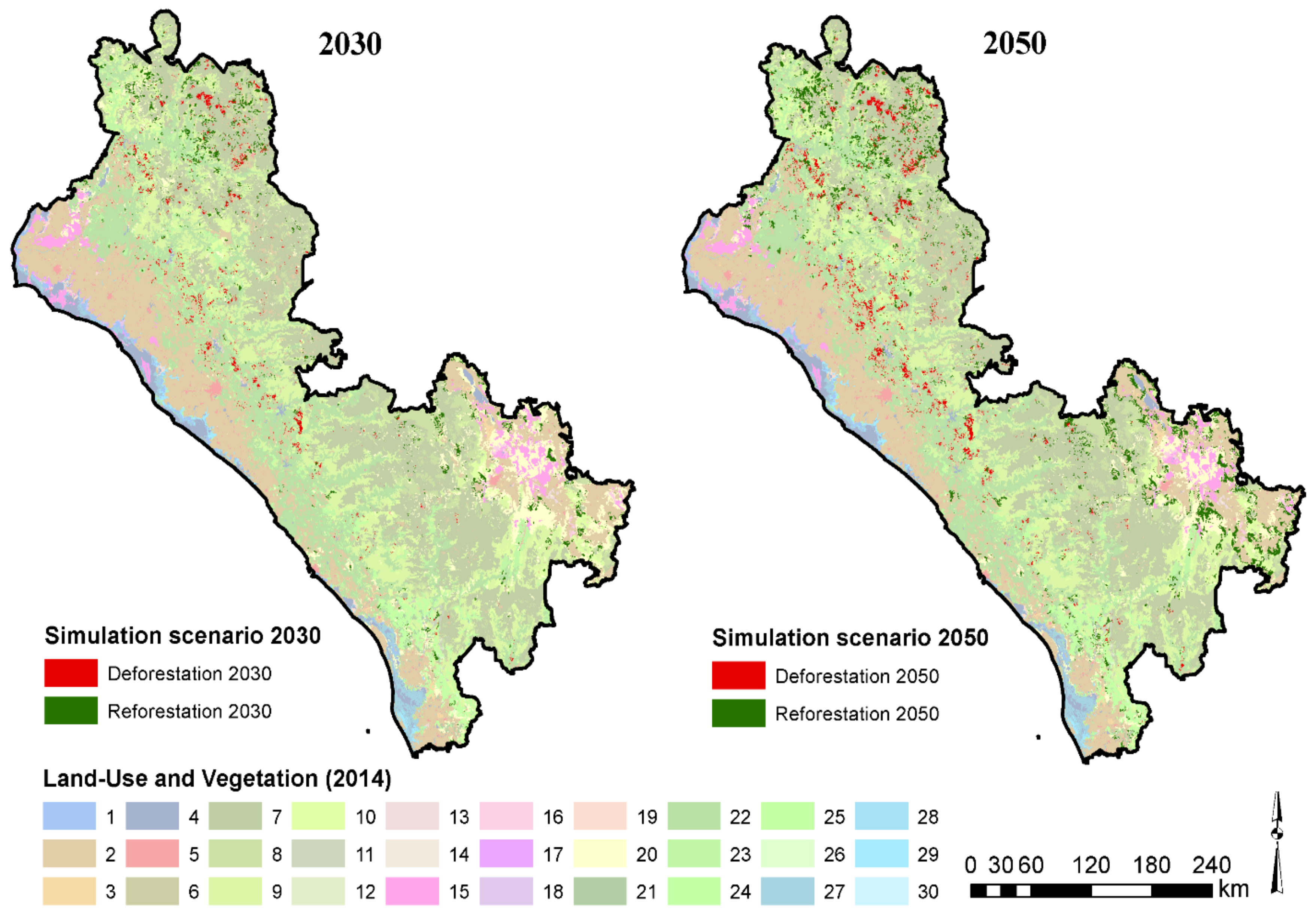

| Data (Year) | Scale/Resolution and Format | Source | Variables (Factors) |
|---|---|---|---|
| Population (2015) | locality numerical | INEGI (http://www3.inegi.org.mx/sistemas/SCITEL/default?ev=3) | Population density; Distance to centres with less than 2500 inhabitants |
| Degrees of marginalization at the local level (2010) | locality numerical | CONABIO http://www.conabio.gob.mx/informacion/gis/ | Marginalization index |
| Digital elevation model (2008) | 90 m Raster | CGIAR (http://srtm.csi.cgiar.org/SELECTION/inputCoord.asp) | Altitude and slope |
| Forest zoning (2012) | 1:250,000 Vector | CONAFOR (https://snigf.cnf.gob.mx/zonificacion-forestal/) | Forest production; Restoration areas |
| Edaphology (2000) | 1:250,000 Vector | INEGI (https://www.inegi.org.mx/temas/mapas/edafologia/) | Soil Types |
| Land-use and Vegetation (LUV) Map (1986; 1993; 2002; 2011; 2014) | 1:250,000 Vector | INEGI (http://www.conabio.gob.mx/informacion/gis/) | Land-use and vegetation; Degraded forests; Distance to agriculture; Distance to pasturelands |
| Protected natural areas (2010) | 1:250,000 Vector | INEGI (http://sig.conanp.gob.mx/website/pagsig/info_shape.htm) CONANP (http://sig.conanp.gob.mx/website/pagsig/info_shape.htm) | Distance to protected natural areas |
| Hydrography (2010) | 1:50,000 Vector | INEGI (https://www.inegi.org.mx/temas/hidrografia/default.html#Descargas) | Distance to hydrography |
| Roads (2014) | 1:50,000 Vector | INEGI (http://www.conabio.gob.mx/informacion/gis/) | Distance to roads |
| National Inventory of Greenhouse Gases of Mexico (2013) | Alphanumeric | INECC & CONAFOR (https://unfccc.int/sites/default/files/resource/ExecutiveSummary_1.pdf) |
| Factors | Minimum Value | Maximum Value | Function | Minimum Normalized Value | Maximum Normalized Value |
|---|---|---|---|---|---|
| Population density | 0 | 43,355.67 | Increasing linear | 0 | 255 |
| Marginalization index | 0 | 60.93 | Increasing linear | 0 | 255 |
| Altitude | 0 | 3308 | User defined | 0 | 255 |
| Slope | 0 | 1149 | User defined | 0 | 255 |
| Forest production | 0 | 3 | Increasing linear | 0 | 255 |
| Soil types | 0 | 7 | Increasing linear | 0 | 255 |
| Land-use and vegetation | 0 | 7 | Increasing linear | 0 | 255 |
| Degraded forests | 0 | 6 | Increasing linear | 0 | 255 |
| Areas for restoration | 0 | 5 | Increasing linear | 0 | 255 |
| Distance to agriculture | 0 | 30,398.19 | Decreasing linear | 0 | 255 |
| Distance to pasturelands | 0 | 65,573.47 | Decreasing linear | 0 | 255 |
| Distance to protected natural areas | 0 | 160,639.30 | Increasing linear | 0 | 255 |
| Distance to hydrography | 0 | 40,462.33 | Decreasing linear | 0 | 255 |
| Distance to roads | 0 | 34,920.63 | Decreasing linear | 0 | 255 |
| Distance to locations with less than 2500 inhabitants | 0 | 33,224.39 | Decreasing linear | 0 | 255 |
| Statistic | Value |
|---|---|
| Determination coefficient (r2) | 98.8% |
| Standard error of the estimate | 279.96 |
| Mean Absolute Error | 173.27 |
| Period | Year | Forest km2 | Deforestation km2 | Reforestation km2 | Annual Average Deforestation km2 | Annual Average Reforestation km2 |
|---|---|---|---|---|---|---|
| 1986 | 101,378.744 | |||||
| 1 (1986–1993) | 1993 | 100,075.291 | 5537.539 | 4234.086 | 791.077 | 604.869 |
| 2 (1993–2002) | 2002 | 98,844.236 | 2645.140 | 1414.085 | 293.904 | 157.121 |
| 3 (2002–2007) | 2007 | 97,696.281 | 2617.308 | 1469.354 | 523.462 | 293.871 |
| 4 (2007–2011) | 2011 | 97,269.517 | 803.263 | 376.499 | 200.816 | 94.125 |
| 5 (2011–2014) | 2014 | 97,452.020 | 1032.442 | 1214.944 | 344.147 | 404.981 |
| 6 (2014–2030) | 2030 | 98,713.520 | 1840.000 | 3101.500 | 115.000 | 193.840 |
| 7 (2030–2050) | 2050 | 101,239.800 | 1900.000 | 4426.280 | 95.000 | 221.314 |
| Criteria | Wc | Factors | Def | Ref | Def | Ref |
|---|---|---|---|---|---|---|
| Wi | Wi | Wj | Wj | |||
| Socioeconomic | 0.15 | Population density | 0.4 | 0.4 | 0.06 | 0.06 |
| Marginalization index | 0.6 | 0.6 | 0.09 | 0.09 | ||
| ∑ | 1 | 1 | ||||
| Biophysics | 0.5 | Altitude | 0.2 | 0.09 | 0.1 | 0.045 |
| Slope | 0.25 | 0.11 | 0.125 | 0.055 | ||
| Forest production | 0.3 | 0.14 | 0.15 | 0.07 | ||
| Soil types | 0.1 | 0.07 | 0.05 | 0.035 | ||
| Land-use and vegetation | 0.15 | 0.2 | 0.075 | 0.1 | ||
| Degraded forests | 0.17 | 0.085 | ||||
| Areas for restoration | 0.22 | 0.11 | ||||
| ∑ | 1 | 1 | ||||
| Proximity | 0.35 | Distance to agriculture | 0.28 | 0.2 | 0.098 | 0.07 |
| Distance to pasturelands | 0.23 | 0.3 | 0.0805 | 0.105 | ||
| Distance to protected natural areas | 0.15 | 0.15 | 0.0525 | 0.0525 | ||
| Distance to hydrography | 0.07 | 0.1 | 0.0245 | 0.035 | ||
| Distance to roads | 0.1 | 0.07 | 0.035 | 0.0245 | ||
| Distance to locations with less than 2500 inhabitants | 0.17 | 0.18 | 0.0595 | 0.063 | ||
| ∑ | 1 | ∑ | 1 | 1 | 1 | 1 |
| Reclassification According to Degree of Suitability | Saaty Pairwise Comparison Matrix | |||||||||
|---|---|---|---|---|---|---|---|---|---|---|
| Occupation and Land Use (Deforestation) | Reclassified Value | Types | 1 | 2 | 3 | 4 | 5 | 6 | 7 | Weights |
| Forest | 1 | 1 | 1 | 0.3543 | ||||||
| Agriculture | 2 | 2 | 1/2 | 1 | 0.2399 | |||||
| Pastureland | 3 | 3 | 1/3 | 1/2 | 1 | 0.1587 | ||||
| Human settlements | 4 | 4 | 1/4 | 1/3 | 1/2 | 1 | 0.1036 | |||
| Other lands | 5 | 5 | 1/5 | 1/4 | 1/3 | 1/2 | 1 | 0.0676 | ||
| Scrub | 6 | 6 | 1/6 | 1/5 | 1/4 | 1/3 | 1/2 | 1 | 0.0448 | |
| Other types of vegetation | 7 | 7 | 1/7 | 1/6 | 1/5 | 1/4 | 1/3 | 1/2 | 1 | 0.0312 |
| Consistency ratio = 0.02 | ||||||||||
| Occupation and Land Use (Reforestation) | Reclassified Value | Types | 1 | 2 | 3 | 4 | 5 | 6 | 7 | Weights |
| Pastureland | 1 | 1 | 1 | 0.3543 | ||||||
| Scrub | 2 | 2 | 1/2 | 1 | 0.2399 | |||||
| Agriculture | 3 | 3 | 1/3 | 1/2 | 1 | 0.1587 | ||||
| Other lands | 4 | 4 | 1/4 | 1/3 | 1/2 | 1 | 0.1036 | |||
| Other types of vegetation | 5 | 5 | 1/5 | 1/4 | 1/3 | 1/2 | 1 | 0.0676 | ||
| Forest | 6 | 6 | 1/6 | 1/5 | 1/4 | 1/3 | 1/2 | 1 | 0.0448 | |
| Human settlements | 7 | 7 | 1/7 | 1/6 | 1/5 | 1/4 | 1/3 | 1/2 | 1 | 0.0312 |
| Consistency ratio = 0.02 | ||||||||||
| Soil Types (Reforestation; Deforestation) | Reclassified Value | Types | 1 | 2 | 3 | 4 | 5 | 6 | 7 | Weights |
| Phaeozem | 1 | 1 | 1 | 0.352 | ||||||
| Regosol | 2 | 2 | 1/2 | 1 | 0.2393 | |||||
| Leptosol | 3 | 3 | 1/3 | 1/2 | 1 | 0.1583 | ||||
| Luvisol | 4 | 4 | 1/4 | 1/3 | 1/2 | 1 | 0.1033 | |||
| Cambisol | 5 | 5 | 1/5 | 1/4 | 1/3 | 1/2 | 1 | 0.0713 | ||
| Vertizol | 6 | 6 | 1/6 | 1/5 | 1/4 | 1/3 | 1/2 | 1 | 0.444 | |
| Other types of soil | 7 | 7 | 1/7 | 1/6 | 1/5 | 1/4 | 1/4 | 1/2 | 1 | 0.0302 |
| Consistency ratio = 0.03 | ||||||||||
| Degraded Forest (Reforestation) | Reclassified Value | Types | 1 | 2 | 3 | 4 | 5 | 6 | Weights | |
| Primary to secondary sub-deciduous forest | 1 | 1 | 1 | 0.3825 | ||||||
| Primary to secondary deciduous forest | 2 | 2 | 1/2 | 1 | 0.2504 | |||||
| Primary to secondary evergreen forest | 3 | 3 | 1/3 | 1/2 | 1 | 0.1596 | ||||
| Primary to secondary mesophilic mountain forest | 4 | 4 | 1/4 | 1/3 | 1/2 | 1 | 0.1006 | |||
| Primary to secondary oak forest | 5 | 5 | 1/5 | 1/4 | 1/3 | 1/2 | 1 | 0.0641 | ||
| Primary to secondary coniferous forest | 6 | 6 | 1/6 | 1/5 | 1/4 | 1/3 | 1/2 | 1 | 0.0428 | |
| Consistency ratio = 0.02 | ||||||||||
| Areas for Restoration (Reforestation) | Reclassified Value | Types | 1 | 2 | 3 | 4 | 5 | Weights | ||
| Forest land with high degradation | 1 | 1 | 1 | 0.4842 | ||||||
| Preferably forest land | 2 | 2 | 1/2 | 1 | 0.2465 | |||||
| Forest land with medium degradation | 3 | 3 | 1/4 | 1/2 | 1 | 0.1445 | ||||
| Forest land with low degradation | 4 | 4 | 1/6 | 1/3 | 1/2 | 1 | 0.0803 | |||
| Forest land or preferably degraded forest | 5 | 5 | 1/9 | 1/5 | 1/4 | 1/2 | 1 | 0.0445 | ||
| Consistency ratio = 0.01 | ||||||||||
| Factors | Deforestation | Reforestation |
|---|---|---|
| Population density | 0.002 | 0.001 |
| Marginalization index | 0.114 | 0.044 |
| Altitude | 0.037 | 0.073 |
| Slope | 0.093 | 0.183 |
| Forest production | 0.236 | 0.416 |
| Soil types | 0.058 | 0.046 |
| Land-use and vegetation | 0.007 | 0.002 |
| Degraded forests | 0.009 | |
| Areas for restoration | 0.017 | |
| Distance to agriculture | 0.079 | 0.059 |
| Distance to pasturelands | 0.046 | 0.01 |
| Distance to protected natural areas | 0.102 | 0.039 |
| Distance to hydrography | 0.002 | 0 |
| Distance to roads | 0.013 | 0.01 |
| Distance to locations with less than 2500 inhabitants | 0.03 | 0.011 |
| Category | Deforestation 2030 | Reforestation 2030 | Deforestation 2050 | Reforestation 2050 | ||||
|---|---|---|---|---|---|---|---|---|
| Living Biomass (Ton/C) | Roots (Ton/C) | Living Biomass (Ton/C) | Roots (Ton/C) | Living Biomass (Ton/C) | Roots (Ton/C) | Living Biomass (Ton/C) | Roots (Ton/C) | |
| Primary coniferous forest | 25,392.83 | 5535.26 | 24,138.33 | 5261.79 | ||||
| Primary oak forest | 8819.17 | 2209.4 | 9419.43 | 2359.78 | ||||
| Primary mountain mesophyll forest | 300 | 300 | ||||||
| Primary woody xerophytic scrub | −524.56 | −134.07 | −894.84 | −12659.43 | ||||
| Pastureland | 81,123.85 | 18017.96 | 111,903.28 | 549,129.84 | ||||
| Primary deciduous forest | 25,630.82 | 5982.56 | 28,616.93 | 6679.55 | ||||
| Primary sub-deciduous forest | 3253.72 | 748.13 | 3389.29 | 779.3 | ||||
| Primary sub-evergreen forest | 145.11 | 33.48 | 241.85 | 55.8 | ||||
| Other lands | 60.29 | 13.39 | 271.32 | 3605.13 | ||||
| Secondary oak forest | 1306.75 | 335.51 | 435.58 | 111.84 | 1500.34 | 385.21 | 1790.73 | 3439.69 |
| Secondary coniferous forest | 3858.73 | 857.04 | 4672.69 | 1037.82 | 3436.68 | 763.3 | 109,73.27 | 815.99 |
| Secondary woody xerophytic scrub | 12.67 | 3.05 | 12.67 | |||||
| Secondary deciduous forest | 16,832.45 | 3875.73 | 13,597.98 | 3130.98 | 17,558.56 | 4042.92 | 15,908.32 | 12,289.46 |
| Secondary sub-deciduous forest | 190.44 | 44.28 | 63.48 | 14.76 | 253.92 | 59.04 | 63.48 | 126.5 |
| Secondary sub-evergreen forest | 62.62 | 14.01 | 62.62 | |||||
| Total | 85,792.64 | 19,635.4 | 99,441.98 | 22,195.73 | 88,855.33 | 20,386.69 | 140,090.85 | 556,747.18 |
Publisher’s Note: MDPI stays neutral with regard to jurisdictional claims in published maps and institutional affiliations. |
© 2020 by the authors. Licensee MDPI, Basel, Switzerland. This article is an open access article distributed under the terms and conditions of the Creative Commons Attribution (CC BY) license (http://creativecommons.org/licenses/by/4.0/).
Share and Cite
Monjardin-Armenta, S.A.; Plata-Rocha, W.; Pacheco-Angulo, C.E.; Franco-Ochoa, C.; Rangel-Peraza, J.G. Geospatial Simulation Model of Deforestation and Reforestation Using Multicriteria Evaluation. Sustainability 2020, 12, 10387. https://doi.org/10.3390/su122410387
Monjardin-Armenta SA, Plata-Rocha W, Pacheco-Angulo CE, Franco-Ochoa C, Rangel-Peraza JG. Geospatial Simulation Model of Deforestation and Reforestation Using Multicriteria Evaluation. Sustainability. 2020; 12(24):10387. https://doi.org/10.3390/su122410387
Chicago/Turabian StyleMonjardin-Armenta, Sergio Alberto, Wenseslao Plata-Rocha, Carlos Eduardo Pacheco-Angulo, Cuauhtémoc Franco-Ochoa, and Jesus Gabriel Rangel-Peraza. 2020. "Geospatial Simulation Model of Deforestation and Reforestation Using Multicriteria Evaluation" Sustainability 12, no. 24: 10387. https://doi.org/10.3390/su122410387
APA StyleMonjardin-Armenta, S. A., Plata-Rocha, W., Pacheco-Angulo, C. E., Franco-Ochoa, C., & Rangel-Peraza, J. G. (2020). Geospatial Simulation Model of Deforestation and Reforestation Using Multicriteria Evaluation. Sustainability, 12(24), 10387. https://doi.org/10.3390/su122410387






